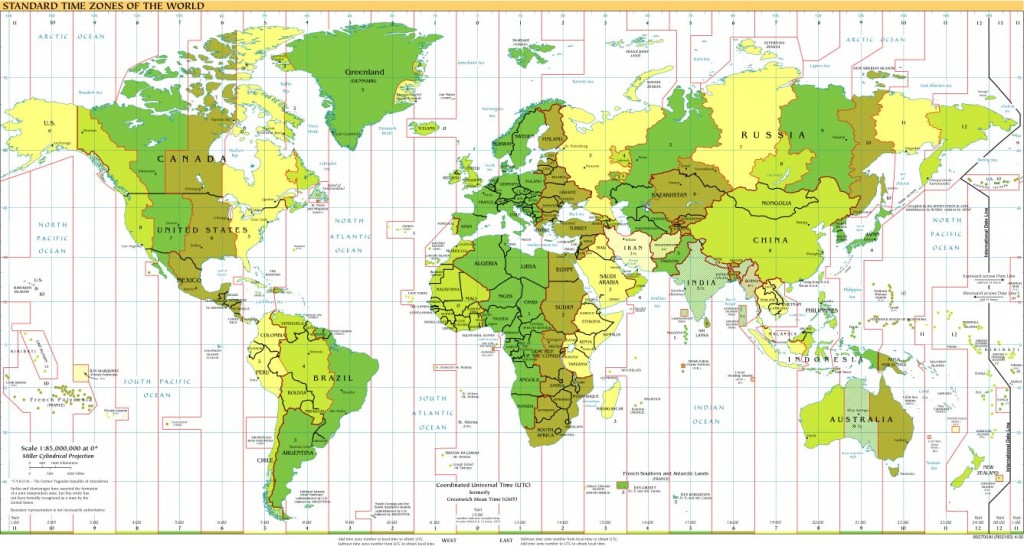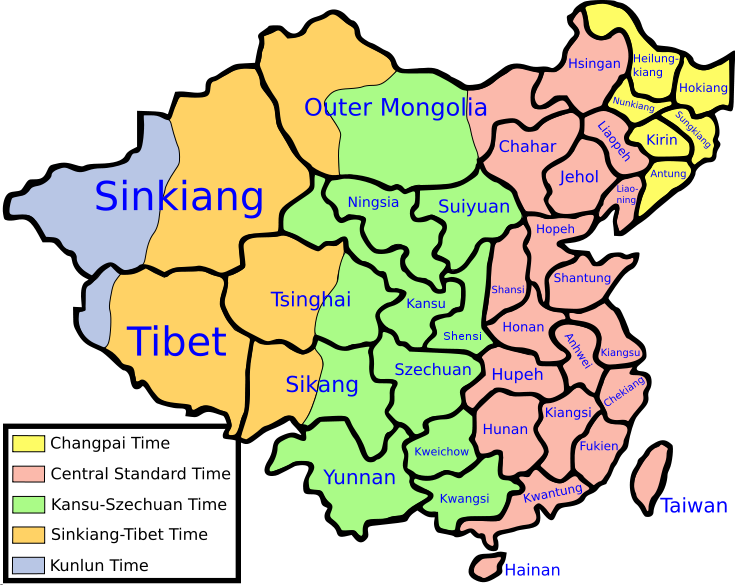In Urumqi, the sun rises a little after seven and sets a little after nine. according to the official, Beijing Time. Solar noon happens a little after two p.m., according to Beijing Time. In Kashgar, our last destination in China, several hundred miles further to the west, it rises around eight and sets at ten. Solar noon occurs at three p.m., Beijing Time.
China is a big country. It is the size of the United States, including Alaska. It should stretch across five timezones. However, if you look at map of the world’s time zones, something strange comes into view; China is a giant monochromatic blob, having only one official timezone: Beijing Time.
Long ago, China had timezones. I have found old maps that show a handful of different colored stripes laid across China. But in 1949, the Communists came to power. Their desire for ultra-centralization, a rejection of any sort of federalism, they did away with time zones. In New China, Beijing was to be the center of, not only politics and culture, but it was also the center of time. All clocks were to be set to the sun in Beijing.
Imagine if all clocks in the United States were set to Washington D.C.’s time, and people in California had to operate on Eastern Standard Time. This is essentially the time regime that the people in Xinjiang live under.
This timezone issue is troubling, but there is a logic to Beijing’s decision. Ninety percent of China’s population lives in the eastern half of the country. Is it not fairer, in a Utilitarian sense, to avoid the troublesomeness of timezones for most people in China by adding this additional burden to the ten percent of the population that lives in China’s far west? The greatest good for the greatest number of people?
However, this timezone plays out in the ethnic conflicts I mentioned in this post. The Uighurs, the largest ethnic group in Xinjiang, see Beijing time as another example of the center’s heavy-handed policies being foisted upon them by the distant capital, another reason to resent Han Chinese rule. We saw this every time we entered a hotel; if it was run by Han Chinese, the clocks behind the counter had Beijing time at the center, then to its sides, it would have Moscow time, New York time, London time and Tokyo time, but never Xinjiang time. In Uighur hotels, Xinjiang time was at the center, and Beijing time was just one among a series of timezones on display.
Mostly, this is a trivial matter. It means you know that midnight is not all that late, and noon is well before you eat lunch.
However, there are small things. Whenever I would call a national hotel chain to make a reservation, their policy is to only hold the room until seven p.m., at the latest. In Beijing, this makes sense, but, in Urumqi, where seven p.m. is actually five p.m., this is way too early to expect someone to arrive at a hotel.
More troubling is the fact that the Han Chinese and the Uighurs seem to operate in two different timezones. It was my impression that Han Chinese not only referred to Beijing time more often than Uighurs, but they also seemed to live in it more.
What I mean is that they seemed to wake up and go to sleep earlier than the Uighurs do. In the Chinese part of town, shops were beginning to open up, even though it was only nine thirty Beijing time (seven thirty Xinjiang time). Yet, when I turned into the Uighur part of town, the streets were dead. No shops were open. Few people were out in the street.
Somehow, thinking in Beijing time, the Han Chinese could not escape living in Beijing time.
This is the problem of empire. The center must hold and the periphery must accommodate that as best as it can. But this connection seems to be breaking apart. I think one of the reasons that violence is breaking out in Xinjiang now is because, as more Han Chinese move out to Xinjiang, more business is being done in Beijing time. More and more, Uighurs have to face the fact that they are being ruled by a distant people who, though they live next door, reside in a distant time zone.


Your timely post coincides with an article in the NY Times (Aug 19) datelined Kashgar re the “Fragrant Concubine,” also known as Iparham or Xiangfei…and the ongoing troubles btwn Han and Uighurs. Keep up the great reporting…right on target. Many thx for continuing coverage. Tom
Thanks Tom. That was a great article. We will be doing our own post on that pretty soon. We felt like they were mostly right, though, I will push back a little on the “busloads of Chinese tourists” converging there. In fact, in the hour or two that we spent there, there were very few people, largely because tourism has been cut back because of the outbreak of violence there. But yea, they had a great analysis of everything going on in Xinjiang.